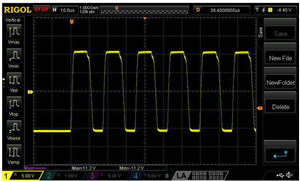Other Parts Discussed in Thread: SN75C185,
I have a customer wanting to use the SN75C185 connected to the MSP430F5418A.
However, they realized that the output waveform of the SN75C185 --> MSP430, more specifically the high/low bit lengths are different.
With a baudrate of 115.2kbit\s, the period for each bit cycle is ~8.7us.
But the HIGH time is approximately 1.2us "too long", while the LOW length is about 1.2us "too short".
For asynchronous UART communication, I am not too clear on this subject, but the MSP430 samples the bit stream multiple times, taking the majority of samples points?
What criteria would need to be met, for such a waveform to work without issue with this MSP430 device?
Any advice/help would be hugely appreciated.
Regards,
Darren


